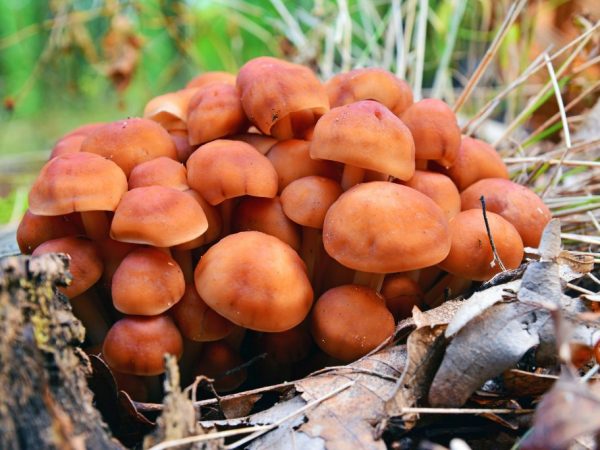Description of the collebium fungus and its varieties
The colibium fungus belongs to the Tricholomaceae family. It has several varieties, among which the most famous for mushroom pickers are wood-loving, broad-lined, oily and fusiform.

Description of the Collibia mushroom and its varieties
general characteristics
All members of the Collibia genus have similar characteristics:
- Hat: finely fleshy, in rare cases has a well-developed pulp, small in size, does not exceed 2 cm in diameter, convex in shape at the initial stage of growth, subsequently flat-spread, in adult specimens a fossa appears in the central part, in young mushrooms it has tucked edges , the color is pale in shades of white, brown and yellow.
- Hymenophore: formed by frequent plates adhered to the bases of the mushroom stem or free, the color of the hymenophore plates can be pale cream or light brown.
- Leg: thin, covered with a mealy bloom, the lower part of the leg is usually hairy, the shape of the leg is often even, cylindrical, in some cases swollen.
Some types of colibia form sclerotia.
Geography of distribution
The genus Colibia is widespread in temperate latitudes in the European and North American territories. In total, there are about 70 varieties, in Russia there are about 20 species. Due to the small size of the cap, mushrooms of this genus are often called "money". Such synonymous names are considered quite scientific.
Colibia are sapotrophs that grow in coniferous and deciduous forests on the rotten fruit bodies of other types of fungi, on forest litter and dried wood, preferring grass and mosses. In rare cases, they settle on living trees.
Varieties
Spindle-footed
Collibia fusiform grows on the stumps and roots of old deciduous trees, preferring oak and beech. A hat with a diameter of 4.0-8.0 cm, with a blunt tubercle. The pulp is tough. The spindle-shaped leg is 4-8 cm long, 0.5-1.5 cm thick. The color range is in red-brown shades.
Widespread in European forests. The fruiting period is in summer and autumn. It is considered inedible, but there are cases of the use of young specimens with exquisite gastronomic qualities. Overgrown specimens cause mild poisoning.
Oil
Colibia oil prefers coniferous forests, grows in colonies. The fruiting period is July-November.
The hat is 2-12 cm in diameter, the surface is smooth, when moisture gets in, it becomes oily, which became the determining factor in the name of the species.
Irina Selyutina (Biologist):
The flesh of the cap of the oil colibia has an interesting feature - hygrophilousness, i.e. it is capable of swelling when exposed to moisture. This happens due to the fact that the trama (false tissue) of such pulp is represented by a loose weave of hyphae. And it is in these gaps between them that the water coming from the environment is retained. Gigrofanny hats are capable of changing color depending on the weather.So, when dry, concentric zones appear on their surface, and their distribution can go from the center to the edge or vice versa.
The color is brown or with shades of red. Mushroom stem 2-10 cm long, 0.4-1.0 cm thick, often hollow, hard, smooth surface. It belongs to the edible species.
Lazy

The fungus grows in colonies
Wood-loving colliery grows in small colonies in mixed woodlands along with oak and pine, preferring decaying wood and fallen leaves. The fruiting period is June-November.
The hat is 1-7 cm in diameter, the color is initially red-brown, later with an orange tint or yellow-brown. The flesh of the cap is thin, whitish, characterized by the presence of hygrophilousness. The mushroom leg is 3-9 cm long and 0.2-0.8 cm thick. Collibia les-loving belongs to the edible species.
Bored
Crowded collibia is found near grassy paths, in clearings in coniferous forests, in hilly areas.
The cap is 1-4 cm in diameter, convex in young specimens, and straightened in adults. The surface is glossy. The hymenophore is pinkish. The leg is in the form of a cylinder, 5-10 cm high, up to 3 mm thick. The fruiting period is in spring-autumn.
The mushroom is an edible variety, but it does not have much culinary value due to its small size.
Wide-lamellar
Colibia broadly lamellar is one of the early lamellar fungi. Grows singly or in small colonies. It is a saprotroph, preferring the rotten stumps of broad-leaved trees.
A hat with a diameter of 5-12 cm, radially cracking in dry weather. A tubercle remains in the center of the cap. In adult mushrooms, the edges may bend upward. The surface is gray or brown. Mushroom stem 4-15 cm, cylindrical, widened at the base, dense in structure.
It belongs to the edible species.
Water-loving
Colibia water-loving, or hymnopus water-loving, grows in forests in wetlands with stagnant water, near the passage to the surface of groundwater, prefers moss, grass and soil rich in woody debris. The fruiting period is mid-May-November.
Mushroom cap with a diameter of up to 6 cm, initially with even, later with wavy edges. The surface is smooth. The color is usually cream, light brown. The leg is up to 8 cm long, 0.2-0.4 cm thick, in the form of a cylinder.
It belongs to the edible variety.
Conclusion
Colibia belongs to the group of basidial lamellar fungi from the Ryadovkovy family. It is a saprotroph. It has several varieties, most of which are edible or conditionally edible.



